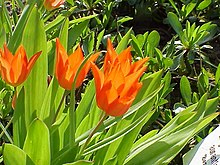Tulipa praestans
| Tulipa praestans | |
|---|---|

| |
| Scientific classification | |
| Kingdom: | Plantae |
| Clade: | Tracheophytes |
| Clade: | Angiosperms |
| Clade: | Monocots |
| Order: | Liliales |
| Family: | Liliaceae |
| Subfamily: | Lilioideae |
| Tribe: | Lilieae |
| Genus: | Tulipa |
| Species: | T. praestans
|
| Binomial name | |
| Tulipa praestans | |
| Synonyms[2][3] | |
|
Tulipa subpraestans Vved. | |
Tulipa praestans is a species of tulip native to the mountains of Tajikistan.[2] Many well known cultivars have been formed from the original plant.[4]
Description
[edit]It is a low-growing tulip species,[5] and has 25–45 cm (10–18 in) tall stems.[4] It has 3 to 7 grey-green leaves that are downy and fringed with hairs (ciliate).[4][5] It can have one flower (normally in the wild[4]) or it can produce multiple flowers per bulb,[6] meaning it can have a pair of flowers or up to a maximum of five flowers per bulb.[4] It blooms in April,[5] with cup shaped flowers.[5][6] The flowers are 5–6.5 cm (2–3 in) wide, in orange-red,[4] orange-scarlet,[5] or scarlet.[6] The anthers are yellow or purple.[4]
Taxonomy
[edit]The specific epithet praestans, refers to the Latin for 'remarkable',[7]' pre - eminent, superior, excellent or distinguished'.[8]
T. praestans was originally described and published by Carl Anton von Meyer in The Gardeners' Chronicle Series 3, Vol.33 on page 239 in 1903.[3][9]
Distribution and habitat
[edit]It is native to temperate areas of Central Asia.[9][4][10]
Range
[edit]It is found in Tajikistan,[9] in the Pamir-Alay mountain system.[6][4]
Habitat
[edit]It grows on rocky slopes, screes, and in light woodland,[6] at an altitude of 3,000 m (9,800 ft) above sea level.[6][5]
Cultivars
[edit]
The following cultivars represent praestans in cultivation: 'Fuselier' always has
- T. praestans Fuselier;[11] grows up to 30 cm tall, with grey-green, lance-shaped leaves and stems in mid spring,[12] bearing between three and five,[4] cup-shaped, brilliant red,[12] or bright red flowers,[13] that can measure to 12 cm across.[12] It has gained the Royal Horticultural Society's Award of Garden Merit.[14] It is valued by gardeners for its low growth height and habit of producing many flowers per bulb. 'Fusilier' even has a sport, 'Unicum'.[15]
- T. praestans 'Unicum',[16] with the leaves edged in cream.[15]
- T. praestans 'Moondance',[17] - has deep orange flowers which are relatively large and have pointy petals.[10]
- T. praestans 'Zwanenburg' - Anna Pavord in her book The Tulip describes ‘Zwanenburg’ as having “.......particularly striking flowers of a rich, clear red, which open more widely than other varieties”. A taller variety at 35 cm.[5]
- T. praestans 'Shogun' - blooming in mid- to late spring, has single, cup-shaped, yellow-orange flowers, flushed red at the base.[18]
- T. praestans 'Tubergen's Variety' - has two to five flowers generally with a basal yellow suffusion and is a good doer, persisting in light soils without annual lifting.[4]
Toxicity
[edit]All parts may cause severe discomfort if ingested. Contact may cause a skin reaction.[18]
References
[edit]- ^ Gard. Chron., ser. 3, 33: 239 (1903)
- ^ a b "Tulipa praestans H.B.May". Plants of the World Online. Board of Trustees of the Royal Botanic Gardens, Kew. 2017. Retrieved 30 August 2020.
- ^ a b "Tulipa praestans H.B.May is an accepted name". theplantlist.org (The Plant List). 23 March 2012. Retrieved 18 April 2020.
- ^ a b c d e f g h i j k "Tulipa praestans". Alpine Garden Society. Retrieved 9 April 2021.
- ^ a b c d e f g "Tulipa praestans 'Zwanenburg'". Retrieved 19 April 2020.
- ^ a b c d e f "Tulipa Species Three | Pacific Bulb Society". www.pacificbulbsociety.org. Retrieved 9 April 2021.
- ^ Stephen Henning The Charaxinae Butterflies of Africa (1989), p. 128, at Google Books
- ^ Robert Samuel Rudolph The Old English Synonyms for "brave" (1967), p. 17, at Google Books
- ^ a b c "Taxon: Tulipa praestans Mast". npgsweb.ars-grin.gov. Retrieved 18 April 2020.
- ^ a b "Moondance Praestans Perennial Tulip 10 Bulbs - Multi Flowering - 10/11 cm Bulbs". Walmart.com. Retrieved 18 April 2020.
- ^ "Tulipa praestans 'Fusilier' (Botanical Tulip)". Gardenia.net. Retrieved 18 April 2020.
- ^ a b c "Tulips that come back year after year". www.flower-gardening-made-easy.com. Retrieved 19 April 2020.
- ^ "Tulipa praestans 'Fusilier' - Plant Finder". www.missouribotanicalgarden.org. Retrieved 18 April 2020.
- ^ "Tulipa praestans 'Fusilier' (15)". The Royal Horticultural Society. Retrieved 1 September 2020.
- ^ a b Wilford, Richard (8 April 2015). The Plant Lover's Guide to Tulips. Timber Press. p. 89. ISBN 9781604696899.
- ^ "PlantFiles: Species Tulip". Dave's Garden. Retrieved 18 April 2020.
- ^ "Tulipa praestans 'Moondance' (15)". rhs.org.uk. Retrieved 18 April 2020.
- ^ a b "Tulipa praestans 'Shogun' (Tulip 'Shogun')". Retrieved 19 April 2020.
Other sources
[edit]- Christenhusz, M. J. M. et al. 2013. Tiptoe through the tulips – cultural history, molecular phylogenetics and classification of Tulipa (Liliaceae). Bot. * J. Linn. Soc. 172:319. Note: lists as Tulipa praestans H. B. May
- Czerepanov, S. K. 1995. Vascular plants of Russia and adjacent states (the former USSR) Cambridge University Press. Note: lists as Tulipa praestans Hoog
- Encke, F. et al. 1993. Zander: Handwörterbuch der Pflanzennamen, 14. Auflage Note: lists as Tulipa praestans Hoog
- Groth, D. 2005. pers. comm. Note: re. Brazilian common names
- Huxley, A., ed. 1992. The new Royal Horticultural Society dictionary of gardening Note: lists as Tulipa praestans Hoog
- Komarov, V. L. et al., eds. 1934–1964. Flora SSSR. Note: lists as Tulipa praestans Hoog
- Walters, S. M. et al., eds. 1986–2000. European garden flora. Note: lists as Tulipa praestans Hoog
